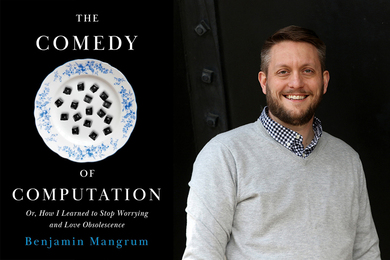For years Dr. Stephanie Seneff has been known throughout the computer science world for her work in natural language processing. A computer scientist with a background in biology, Seneff received her undergraduate degree in biophysics before moving to electrical engineering and computer science for her MS and PhD degrees. For over 30 years, she worked on developing new computational systems aimed at providing insight on biological challenges, including the human auditory system, gene prediction and human language with the goal of improving human-computer interaction.
When her husband was diagnosed with heart disease six years ago and subsequently placed on statin drugs, they were both alarmed when side effects appeared immediately. Seneff vowed to learn more about statin drugs to ensure her husband was receiving the best medical treatment possible. Using the same analytical computer science skills she had developed over the years through her research, Seneff decided to take a similar approach to the study of medicine.
“Drawing on my background in biology, I started reading anything I could find about statin drugs and related research explaining their effects. I also found clinical data about their impact on humans, and was shocked by the adverse effects statin drugs have,” Seneff says. “Being a computer scientist, I started gathering all these drug side effect reports that I found online. I then took all of this information — the research literature and the drugs side effect reports — and applied my computer science programs to decipher the content.”
Using standard computer science techniques, Seneff compared the side effects of statin drugs to other drugs taken by humans within the same age distribution. She found many adverse side effects stemming from the usage of statin drugs, and through this work saw a new path for her research: Using computer science techniques to understand human biology, in particular the relationship between nutrition and health.
Based on her experience developing natural language processing algorithms that could parse phrases and locate key words, Seneff developed a way to exploit computer science methods to help her understand how drugs and environmental toxins impacted human health. To study the interaction between health and environmental factors like drugs and toxic chemicals, Seneff found that it was a natural choice to simply modify the natural language processing algorithm she and her colleagues had already developed to analyze and build summaries of restaurant reviews.
Seneff describes her method as a traditional, systems-level computer science approach to biological problems. The technique works by analyzing specific sections of research papers and testimonials documenting drug side effects for unusual statistical frequencies of key symptom-related words like fatigue or nausea, but also for biological terms like homocysteine and glutathione. Seneff then looks at the correlation statistics to see which keywords tend to appear together in the same paragraph or the same drug side effect report. Based on the statistical data, Seneff applies her findings to the research literature to see if she can draw a connection between any of the symptoms documented in the side effect reports, the biologically related words in the research literature, and environmental toxins or medications being used by the selected population.
“My approach is a systems-level biology approach using simple computer science techniques to help organize the facts. The underlying theme is collecting data from people who are experiencing problems and who live in a particular environment. You examine the data using our computer science techniques, and then you can link specific environments with specific problems. When you go back to the research literature, you can examine what certain materials like glyphosate do to human biology,” says Seneff. “You can then build a hypothesis by studying the research literature and the web-based documentation of symptoms.”
Seneff has applied her technique to understanding everything from Alzheimer’s disease and autism to studying the impact of nutritional deficiencies and environmental toxins like herbicides. Since, 2011 she has published 10 papers in various medical and health-related journals. Her findings have shocked the medical world, as she has shown connections between herbicides like glyphosate and the disruption of the human body’s gut bacteria, depletion of essential amino acids and interference with necessary enzymes, possibly leading to Alzheimer’s, autism, obesity and more.
While Seneff’s approach and findings are unconventional to some, she believes her approach to using computer science to better understand the interaction between human health and environmental toxins provides a new viewpoint that could prove insightful.
“In my work I am using a combination of simple but potent computer science tools to understand biology. I think it’s really important to use computer science as a tool to understand biology and to think of biology at a systems level,” Seneff says. “I am trying to look at the whole system and understand all of the interactions between different parts, which may be a product of my training as a computer scientist. I think computer scientists view the problem differently than biologists.”
When her husband was diagnosed with heart disease six years ago and subsequently placed on statin drugs, they were both alarmed when side effects appeared immediately. Seneff vowed to learn more about statin drugs to ensure her husband was receiving the best medical treatment possible. Using the same analytical computer science skills she had developed over the years through her research, Seneff decided to take a similar approach to the study of medicine.
“Drawing on my background in biology, I started reading anything I could find about statin drugs and related research explaining their effects. I also found clinical data about their impact on humans, and was shocked by the adverse effects statin drugs have,” Seneff says. “Being a computer scientist, I started gathering all these drug side effect reports that I found online. I then took all of this information — the research literature and the drugs side effect reports — and applied my computer science programs to decipher the content.”
Using standard computer science techniques, Seneff compared the side effects of statin drugs to other drugs taken by humans within the same age distribution. She found many adverse side effects stemming from the usage of statin drugs, and through this work saw a new path for her research: Using computer science techniques to understand human biology, in particular the relationship between nutrition and health.
Based on her experience developing natural language processing algorithms that could parse phrases and locate key words, Seneff developed a way to exploit computer science methods to help her understand how drugs and environmental toxins impacted human health. To study the interaction between health and environmental factors like drugs and toxic chemicals, Seneff found that it was a natural choice to simply modify the natural language processing algorithm she and her colleagues had already developed to analyze and build summaries of restaurant reviews.
Seneff describes her method as a traditional, systems-level computer science approach to biological problems. The technique works by analyzing specific sections of research papers and testimonials documenting drug side effects for unusual statistical frequencies of key symptom-related words like fatigue or nausea, but also for biological terms like homocysteine and glutathione. Seneff then looks at the correlation statistics to see which keywords tend to appear together in the same paragraph or the same drug side effect report. Based on the statistical data, Seneff applies her findings to the research literature to see if she can draw a connection between any of the symptoms documented in the side effect reports, the biologically related words in the research literature, and environmental toxins or medications being used by the selected population.
“My approach is a systems-level biology approach using simple computer science techniques to help organize the facts. The underlying theme is collecting data from people who are experiencing problems and who live in a particular environment. You examine the data using our computer science techniques, and then you can link specific environments with specific problems. When you go back to the research literature, you can examine what certain materials like glyphosate do to human biology,” says Seneff. “You can then build a hypothesis by studying the research literature and the web-based documentation of symptoms.”
Seneff has applied her technique to understanding everything from Alzheimer’s disease and autism to studying the impact of nutritional deficiencies and environmental toxins like herbicides. Since, 2011 she has published 10 papers in various medical and health-related journals. Her findings have shocked the medical world, as she has shown connections between herbicides like glyphosate and the disruption of the human body’s gut bacteria, depletion of essential amino acids and interference with necessary enzymes, possibly leading to Alzheimer’s, autism, obesity and more.
While Seneff’s approach and findings are unconventional to some, she believes her approach to using computer science to better understand the interaction between human health and environmental toxins provides a new viewpoint that could prove insightful.
“In my work I am using a combination of simple but potent computer science tools to understand biology. I think it’s really important to use computer science as a tool to understand biology and to think of biology at a systems level,” Seneff says. “I am trying to look at the whole system and understand all of the interactions between different parts, which may be a product of my training as a computer scientist. I think computer scientists view the problem differently than biologists.”






